Perched on the borders of Gujarat and Rajasthan, the Ambaji Mata Temple isn’t just a pilgrimage site—it’s an experience that stirs the soul. Whether you’re a seeker of blessings, a lover of mythology, or a curious traveler, the temple has something unique to offer. With no idol inside, yet thousands swarming every day, you might wonder—what exactly makes Ambaji so powerful?
Let’s take you on a journey into the heart of devotion, heritage, and mystique.
🕉️ The Mythology: Where the Goddess Resides in Symbol, Not Form
The Ambaji Mata Temple is one of the 51 revered Shaktipeethas, sacred spots where parts of Sati’s body are believed to have fallen. Legend holds that the heart of Goddess Sati fell here, saturating the land with immense divine energy.
Unlike most temples, Ambaji doesn’t house a physical idol. Instead, worshippers bow to a “Shree Visa Yantra,” a sacred geometric representation of the goddess. It is never shown to the public, keeping the mystery—and the faith—intact. This unique form of worship sets Ambaji apart, reminding us that divinity isn’t always about what we see, but what we feel.
When I first stood before the sanctum of Ambaji Mata Temple, I expected a grand idol—something carved in stone or metal, as in most temples. But instead, I was met with a quiet mystery: no idol, just a red silk cloth gently fluttering over the sacred Shree Visa Yantra. A soft fragrance of sandalwood hung in the air, and the rhythmic chants seemed to pause time. I remember feeling an odd yet profound pull, as if the unseen presence of the goddess was more powerful than any physical form. There was reverence, yes—but also an intimacy, like I was being let into a sacred secret shared by generations of silent worshippers. I didn’t see the yantra, but I felt it—and that feeling hasn’t left me since.
Historical Background: From Tribal Worship to Grand Architecture
While exact historical records are hazy, it’s widely believed that the worship at Ambaji dates back to the pre-Vedic era. Tribal communities, especially the Bhils, were among the first to worship the goddess as a local deity.
Later, the Paramara kings of Rajputana and Solanki rulers of Gujarat are believed to have contributed to temple development. Over time, the shrine evolved into a grand structure, welcoming devotees from across the country. Even today, the temple echoes the footsteps of centuries past—each stone a testament to the region’s unwavering devotion.
📍 Geographical Location: Where Gujarat Meets Rajasthan
Ambaji is located on top of the Aravalli hills in Banaskantha district of North Gujarat, right on the Gujarat-Rajasthan border.
- Latitude: 24.33° N
- Longitude: 72.85° E
- Altitude: Around 500 meters above sea level
Its unique position not only gives it a strategic importance but also makes it accessible from both western and northern India. The town is also near Mount Abu, making it part of a broader spiritual and scenic circuit.
How to Reach Ambaji Mata Temple
Reaching Ambaji is relatively simple, thanks to its connectivity by road, rail, and air:
By Air ✈️
The closest airport is Sardar Vallabhbhai Patel International Airport, Ahmedabad (180 km), well-connected to all major Indian cities. From there, a 4-hour road journey takes you to Ambaji.
By Train 🚆
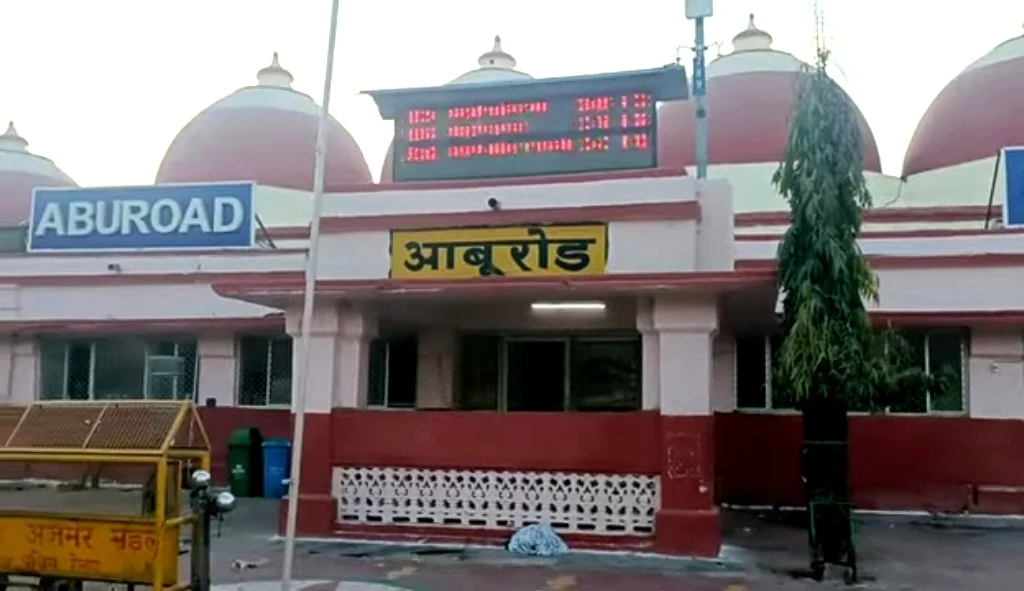
The nearest railway station is Abu Road (20 km). It’s a key stop on the Delhi-Ahmedabad rail route. From there, local taxis and buses are available to Ambaji.
By Bus 🚌
Ambaji is well connected by GSRTC buses from major cities in Gujarat like Ahmedabad, Palanpur, and Mehsana. Private taxis and buses are also available from Rajasthan.
By Car 🚗
For road-trippers, Ambaji offers scenic routes from both Gujarat and Rajasthan. The roads are well maintained and pass through picturesque hills and forests.
I started my journey from Kolkata, boarding the Howrah-Ahmedabad Superfast Express. The journey, though long, was comfortable and offered a chance to see the changing landscapes of India. After reaching Abu Road, I hopped onto a local bus that took about 40 minutes to reach Ambaji. Watching the hills slowly rise in the distance as we neared the temple town felt like approaching something sacred.
Where to Stay: From Dharamshalas to Hotels 🏨🛏️
Ambaji offers a wide range of accommodations to suit every budget:
Budget Dharamshalas
- Examples: Shree Muktidham, Shreenathji Bhawan
- Distance from temple: Approximately 0.5 km
- Price range (INR): ₹200–500
Mid-Range Hotels
- Examples: Hotel Ambaji International, Hotel Gopinath
- Distance from temple: 1–2 km
- Price range (INR): ₹800–1500
Luxury Stays
- Example: Hotel Royal Inn (Abu Road)
- Distance from Ambaji: Around 20 km
- Price range (INR): ₹2000+
During my visit, I chose to stay at Hotel Ambaji International, just a short walk from the temple. What stood out immediately was the warm hospitality—I was greeted with a cheerful “Jai Ambe Maa” at check-in, and that energy flowed through every interaction. The rooms were clean and comfortable, and I particularly appreciated the early morning tea service before heading for darshan. It wasn’t a luxurious stay, but it felt sincere—like the staff genuinely understood why I was there.
Tip: During festivals like Bhadarvi Poonam, book well in advance as places fill up quickly.
Architecture: A Fusion of Simplicity and Grandeur
Despite being one of the most important Shaktipeethas, the temple’s architecture is relatively minimalistic.
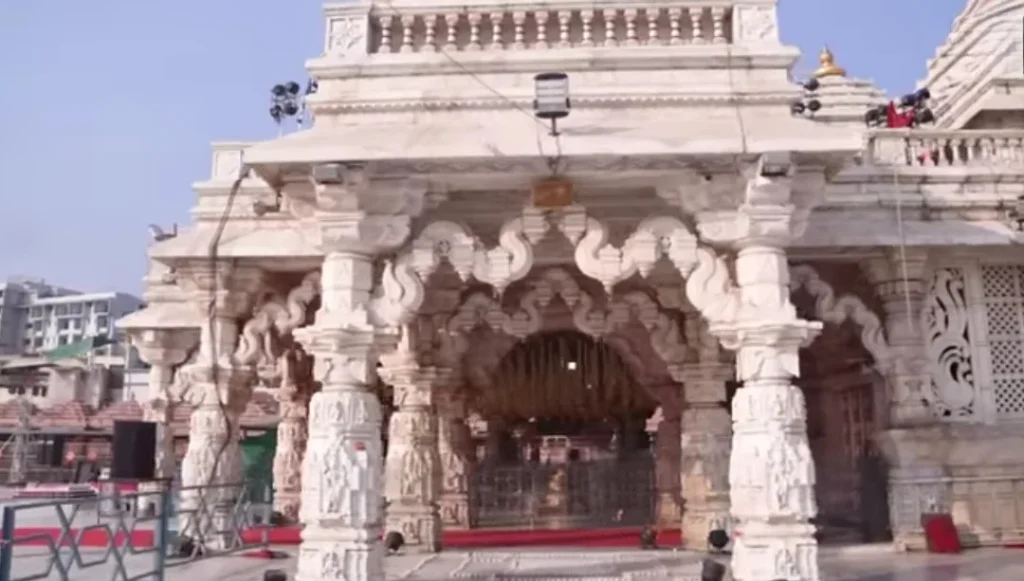
- The temple is built using white marble, giving it an elegant glow under sunlight.
- The main sanctum houses the Shree Visa Yantra, covered with a red cloth and surrounded by floral decorations.
- Pillars and walls feature traditional Gujarati carvings, especially floral motifs and mythological scenes.
The simplicity of the structure reflects a profound spiritual idea—less is more when it comes to divine experience.
Best Time to Visit 🌸🌤️
While Ambaji can be visited year-round, certain months offer a more comfortable and festive experience.
Winter (November – February):
- Weather: Pleasant (10–25°C)
- Ideal for sightseeing and darshan with minimal discomfort
Summer (March – June):
- Weather: Hot (28–42°C)
- Best avoided unless necessary due to high temperatures
Monsoon (July – September):
- Weather: Humid with moderate rainfall
- Offers lush greenery and relatively lighter crowds
Festive Season (August – September):
- Features: Bhadarvi Poonam celebrations
- Peak pilgrimage time—vibrant, crowded, and spiritually charged
Festivals: The Soul of Ambaji 🎉🎡
The Bhadarvi Poonam (full moon in Bhadrapada, August-September) is the biggest celebration here, attracting over a million pilgrims.
Highlights include:
- 51-mile parikrama (circumambulation) around sacred hills
- Nights that come alive with traditional Garba dance and folk music
- Bustling streets filled with food stalls, local crafts, and devotional merchandise
The energy during this time is nothing short of electric. Dressed in vibrant chaniya cholis and kediyus, devotees swirl in unison, their claps and twirls echoing through the night air under the open sky. The rhythm, the lights, the chants—it’s an experience that transcends religion and becomes pure celebration.
Have you ever experienced the Garba dance during Bhadarvi Poonam? Tell us about it in the comments—we’d love to hear your story!
Other important festivals:
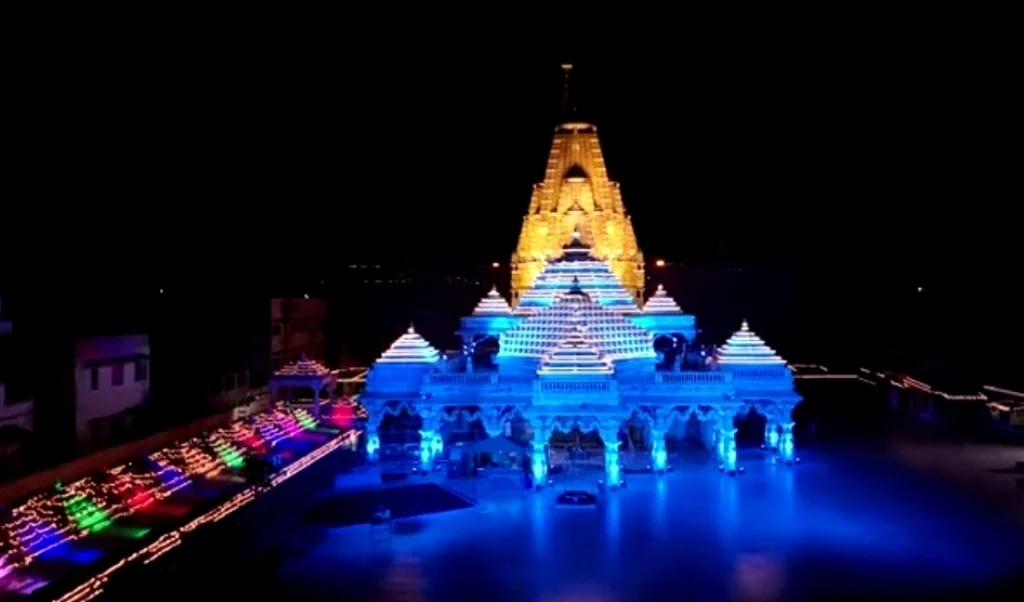
- Navratri: Nine days of fervent prayers and Garba
- Diwali: Illuminated temple and local fairs
- Chaitra Navratri: Spring version of the main Navratri
Ambaji’s festivals aren’t just events—they’re emotions shared by millions.
Local People & Culture: A Blend of Devotion and Warmth 🤝🌿
Ambaji is more than a town—it’s a living, breathing testament to collective faith. The local people, rooted deeply in tradition, welcome pilgrims with a hospitality that feels like home.
You’ll often meet communities like the Rabaris, Garasiyas, and Bhils, who have worshipped Ambaji Mata for generations. Their customs—vibrant attire, intricate embroidery, devotional songs—are not just cultural, but spiritual expressions.
While sipping chai outside the temple after the evening aarti, I once spoke with an elderly woman from a nearby village. Draped in a vibrant red saree, she had walked barefoot for miles. I asked her, “Does it ever feel strange—coming all this way to a temple without an idol?”
She smiled, eyes glinting with quiet wisdom.
“Beta,” she said, “an idol is for the eyes, but faith is for the soul. Here, the Mata doesn’t sit on a throne—she sits inside you.”
That brief moment said more than any guidebook could. In Ambaji, devotion isn’t explained—it’s lived.
Don’t leave without tasting local Gujarati snacks like khaman, fafda, and gathiya, sold by cheerful vendors who never forget to say “Jai Ambe Maa” with every transaction.
Nearby Attractions: Explore Beyond the Temple 📸
If you’re planning a longer trip, these nearby destinations make for enriching detours:
Gabbar Hill: The Sacred Peak of Shakti Peethas
Gabbar Hill, located just 5 km from the famous Ambaji Temple in Gujarat, is a revered site steeped in mythology and natural beauty. It stands as a spiritual cornerstone for devotees of the goddess Amba, believed to be one of the 51 Shakti Peethas in India. According to legend, this is the very hill where the heart of Goddess Sati fell after Lord Vishnu dismembered her body to calm Lord Shiva’s rage. Today, thousands of pilgrims climb its 999 stone steps to offer prayers and seek blessings.
A ropeway now makes the climb easier for those who can’t manage the stairs. Alongside, the hill is adorned with a large Jyot (eternal flame) that burns continuously and is considered highly auspicious.
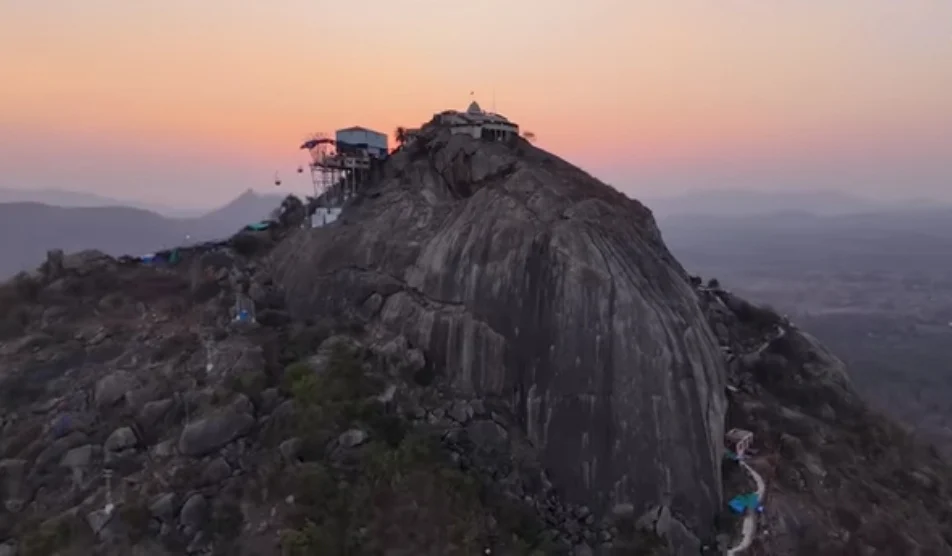
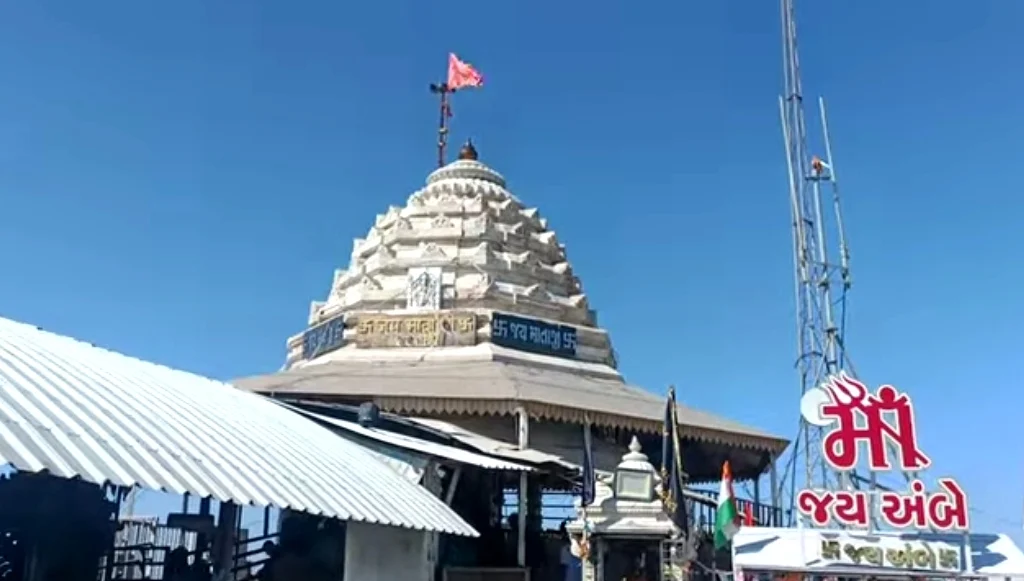
Kumbhariya Jain Temples: A Hidden Architectural Gem
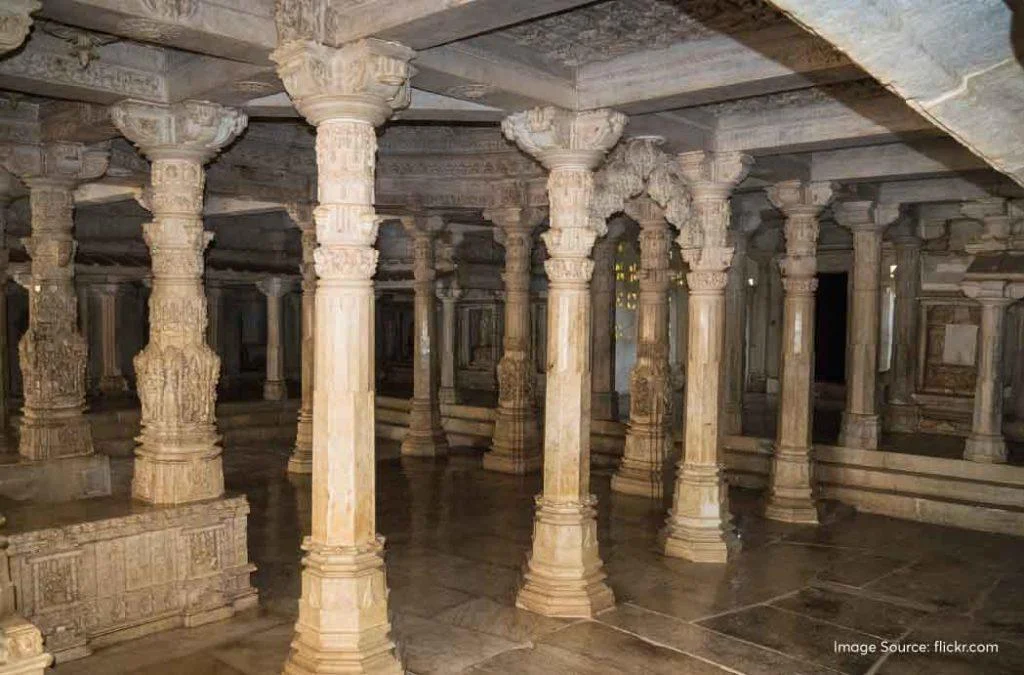
Just a short drive from Ambaji, the Kumbhariya Jain Temples are an absolute architectural treasure that many pilgrims surprisingly overlook. This cluster of five exquisitely carved Maru-Gurjara style temples dates back to the 11th–13th century and is dedicated to various Jain Tirthankaras, including Lord Mahavira.
What makes these temples extraordinary is the sheer intricacy of the carvings. Each pillar, arch, and dome seems to tell its own story—floral motifs, celestial dancers, and divine scenes come alive in stone. The symmetry, precision, and grace of the craftsmanship reflect a level of artistry that rivals the famous Dilwara Temples of Mount Abu, but with far fewer crowds.
If you’re visiting Ambaji, do not miss Kumbhariya—it’s like stumbling upon a hidden page in India’s grand spiritual and artistic history.
Kailash Tekri Mahadev Temple: A Serene Escape into Divinity
Perched atop a tranquil hill near Ambaji in Gujarat, Kailash Tekri Mahadev Temple is a hidden gem that blends devotion, natural beauty, and peace. Dedicated to Lord Shiva, this sacred site invites pilgrims and travelers alike to pause, reflect, and immerse themselves in spiritual calm.
The temple stands at a scenic location just 2 km from the main Ambaji Temple. Surrounded by the lush Aravalli ranges, Kailash Tekri offers panoramic views of the surrounding valleys. The climb to the temple is gentle, and the pathway—flanked by greenery and occasional resting spots—makes the journey soothing, especially during early morning or late afternoon.
If you’re planning a visit to Ambaji, include Kailash Tekri Mahadev Temple in your itinerary. The divine energy and the natural charm of the hilltop shrine will stay with you long after your journey ends.
Mansarovar Kund: The Holy Bath Before Darshan
Mansarovar Kund, located near the Ambaji Temple in Gujarat, holds immense religious significance for devotees. This sacred water reservoir is believed to purify the body and soul, preparing pilgrims spiritually before they enter the temple premises for darshan of Goddess Amba.
According to legend, the Kund was created by divine intervention and has been a site of ritual purification since ancient times. Even today, thousands of devotees take a holy dip here before offering prayers at the Ambaji Temple. The belief is strong—those who bathe in the waters of Mansarovar Kund are blessed with good fortune, health, and spiritual awakening.
Mangalya Van: Astrological Garden atop Kailash Tekri
Nestled just 1–1.5 km from the Ambaji Temple, Mangalya Van crowns the tranquil Kailash Tekri hillock. Developed by the Gujarat Forest Department, this garden stands out for its unique Rashi Van—an astrological garden where each zodiac sign has been planted three specific plants over an 18×18‑metre plot.
Mangalya Van features well-maintained walking paths lined with flowering shrubs, small water bodies, sculpted “Om” motifs, and mythological figures scattered across the lush terrain. The peaceful layout draws families, photographers, yogis, and meditation seekers alike
Tips & Practical Info
- Best visited early in the morning for a quiet experience and pleasant weather.
- Avoid monsoon season due to slippery steps and pathways.
- Entry timings are generally from around 8:00 AM to 6:30 PM daily
Conclusion: A Place Where the Goddess Whispers to Your Soul 🙏
The Ambaji Mata Temple isn’t just a place on the map—it’s a spiritual heartbeat. Whether you’re watching a Garba swirl into the night or quietly bowing before the invisible yantra, there’s a force here that speaks in silence. It’s not about religion alone—it’s about connection, peace, and energy.
Have you visited Ambaji or plan to? Share your experiences in the comments!
📌 Bookmark this guide for your trip planning.
🔔 subscribe for more sacred travel stories from across India. And remember—some places don’t need idols to be divine. Ambaji is one of them.
External Resource: Gujrat Tourism



